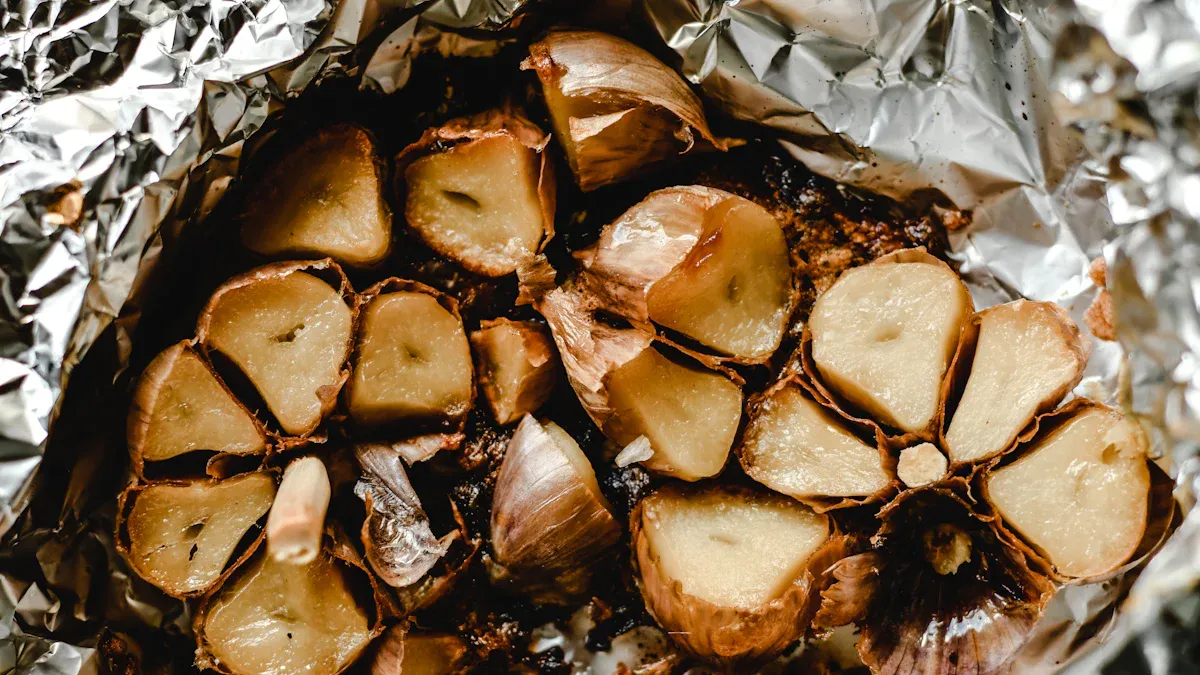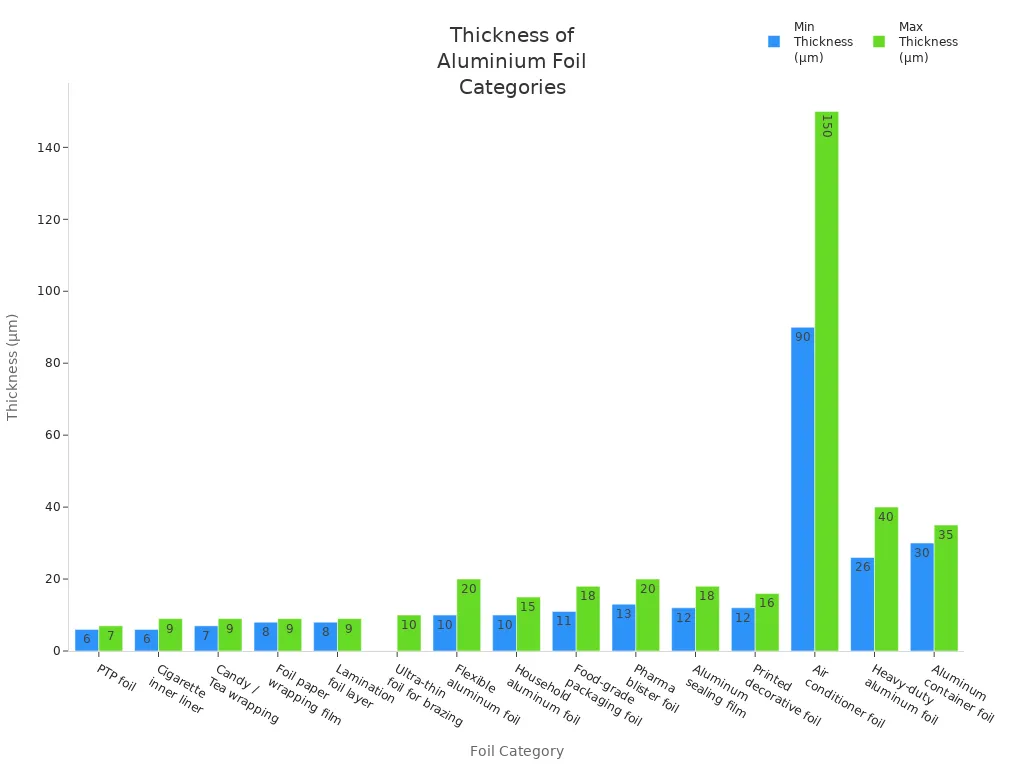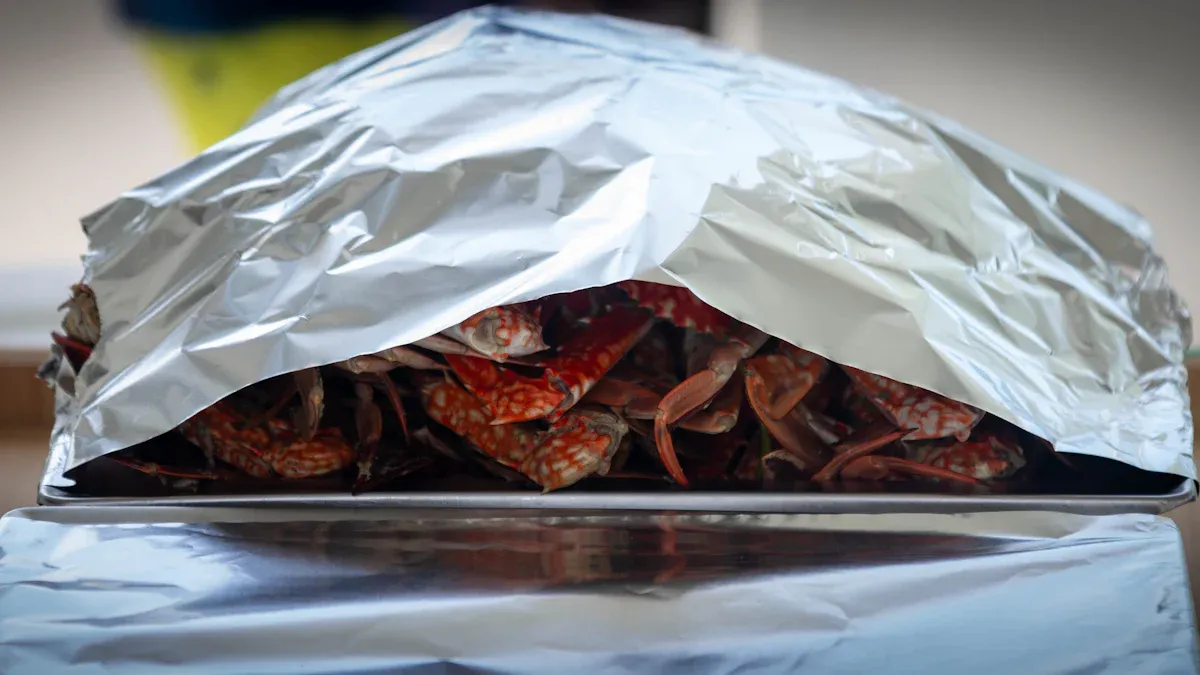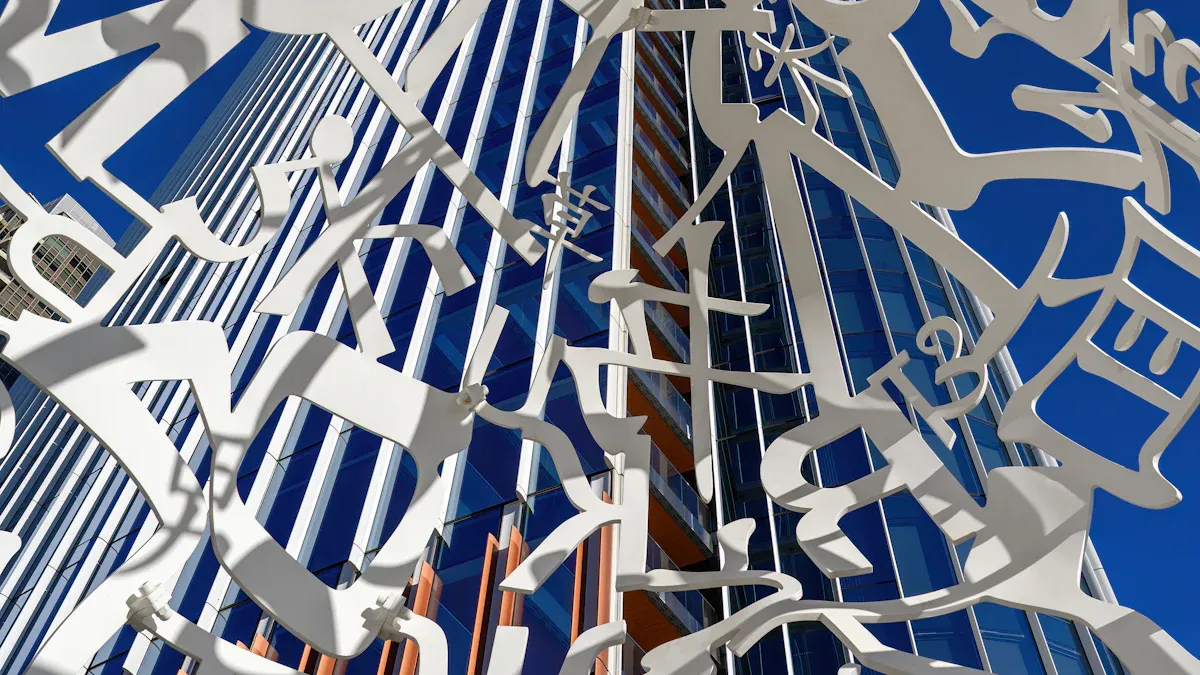Aluminium foil for food packaging is widely utilized. There are seven main types that people commonly use: basic foil, heavy-duty, extra heavy-duty, laminated lids, containers, corrosion-resistant laminates, embossed, and colored foil.
- 67% of people use foil to wrap leftovers.
- Standard foil accounts for more than half of the market.
You can select the type of aluminium foil for food packaging that works best for you.
Key Takeaways
- Pick the best aluminum foil for what you need. Basic foil works well for daily use. Heavy-duty foil is better for grilling and baking.
- Aluminum foil helps food stay fresh. It blocks moisture, air, and light. This stops food from going bad. It also keeps the taste good.
- Recycling aluminum foil is simple and good for nature. Clean foil can be recycled. This cuts down on trash and saves energy.
Overview of Aluminium Foil for Food Packaging
Types and Uses
There are many kinds of aluminium foil for food. Each kind has a different thickness. Each one is used for different things. The table below shows how they compare:
| Category | Thickness (μm) | Main Uses | Key Benefits |
|---|---|---|---|
| Household aluminum foil | 10–15 | Baking, wrapping, food preservation | Flexible, easy to use, good protection |
| Heavy-duty aluminum foil | 26–40 | Grilling, baking, storing moist foods | Strong, resists tearing, handles heat |
| Extra heavy-duty foil | 30–40 | Catering, bulk packaging | Maximum durability, protects large portions |
| Laminated lids | 12–18 | Sealing containers, dairy products | Easy to tear, oil resistant |
| Aluminum container foil | 30–35 | Disposable trays, lunch boxes | Rigid, keeps shape, good heat conduction |
| Corrosion-resistant laminates | 8–9 | Multi-layer packaging, long shelf life foods | Blocks moisture, oxygen, and light |
| Embossed/colored foil | 12–16 | Decorative packaging, chocolates, gifts | Attractive, customizable, preserves aroma |
Standard foil is good for daily kitchen jobs. Heavy-duty foil is best for grilling and baking. Extra heavy-duty foil keeps food safe when moving or storing a lot. Laminated lids close containers tightly. Aluminum foil containers are handy for takeout and catering.
Key Benefits
Aluminium foil packaging has many good points:
- It is light, so you can carry it easily and shipping costs less.
- It keeps out moisture, oxygen, and light, so food stays fresh.
- You can wrap, shape, or seal many foods with it.
- You can recycle aluminium foil, which helps the planet.
- It is strong and does not tear easily, so food stays safe.
- Colorful and embossed foil looks nice and helps brands stand out.
Thickness and grade are important. Thicker foil keeps air and water out better. It also stops food from getting holes. Food-grade foil is safer because it lowers chemical risks. Always check if the foil can be recycled to help the environment.
Basic Aluminium Foil
Description
You see basic aluminium foil in many kitchens and stores. This foil is thin and bends easily. You can wrap it around food or containers. Basic aluminium foil protects food from air and water. It also blocks light. This keeps food fresh and safe.
Here is a table that shows why basic aluminium foil is good for food packaging:
| Property | Description |
|---|---|
| Lightweight | It is much lighter than other metals. You can carry and move it easily. |
| Thermal Conductivity | It spreads heat well. This helps with cooking and keeping food warm. |
| Chemical Inertness | It does not react with most foods. It is safe to touch food. |
| UV Resistance | It stops harmful UV rays. This protects foods that are sensitive. |
| Non-toxic and Odorless | It does not change how food tastes or smells. |
| Flexibility and Thinness | It bends and wraps around many shapes and sizes. |
Tip: You can recycle aluminium foil after you use it. This helps cut down on trash and keeps the earth clean.
Uses in Food Packaging
You can use basic aluminium foil for many foods. It works for dry foods and wet foods. Here are some foods you might see wrapped in aluminium foil:
- Peas and beans
- Milk powders and soup powders
- Cake mixes
- Sweet sauces and savory sauces
- Herbs and spices
- Yeast
- Instant drinks like chocolate, malt drinks, tea, and coffee
- Dry cheese like powdered Parmesan
- Stock cubes for meat, fish, or chicken
- Biscuits
- Powdered dessert sauces
You can use aluminium foil to wrap leftovers. You can line baking trays or cover dishes. It keeps food fresh and stops flavors from mixing. Many people pick aluminium foil for food packaging because it is safe, simple, and works well.
Heavy-Duty Aluminium Foil
Description
Heavy-duty aluminium foil is thicker and stronger than basic foil. You can feel it is sturdier when you touch it. The extra thickness helps stop tears and holes. This kind of foil is best when you need more food protection.
Here is a table that shows how heavy-duty aluminium foil is different from standard foil:
| Feature | Standard Aluminum Foil | Heavy Duty Aluminum Foil | What Makes Heavy Duty Special |
|---|---|---|---|
| Typical Thickness | 0.016 – 0.024 mm | > 0.025 mm | Thicker and more durable |
| Strength (Tensile) | Lower | Higher | Resists stretching and breaking |
| Puncture Resistance | Lower | Significantly Higher | Less likely to get holes |
| Tear Resistance | Lower | Higher | Harder to rip |
| Rigidity / “Dead Fold” | More Flexible | More Rigid | Holds shape after folding |
| Barrier Properties | Excellent | Excellent+ | Better at keeping out air and water |
| Heat Resistance | Good | Good to Excellent | Handles high heat better |
| Weight (per unit area) | Lighter | Heavier | Feels sturdier |
| Cost (per unit area) | Lower | Higher | Costs more but lasts longer |
| Typical Applications | Light food wrapping | Grilling, baking, bulk | Handles tough jobs |
You use heavy-duty aluminium foil for grilling, baking, or storing sharp foods. It is good for wrapping meats or covering pans. You can also line grill trays with it.
Benefits
Heavy-duty aluminium foil has many good points:
- You can wrap strong foods like ribs or roasted veggies.
- It keeps food safe from tearing, even with bones or hard edges.
- You can use it in ovens or on grills because it takes high heat.
- It blocks moisture, air, and light, so food stays fresh.
- You can shape it to fit pans, and it keeps its shape.
Tip: Heavy-duty aluminium foil is great for outdoor cooking, catering, and storing leftovers that need more protection.
When you pick aluminium foil for food, heavy-duty foil helps you worry less. Your food will stay safe, fresh, and well-covered.
Extra Heavy-Duty Foil
Description
You will notice extra heavy-duty aluminium foil feels much thicker and stronger than regular foil. This type of aluminium foil is designed for tough jobs in the kitchen. You can use it when you need maximum protection for your food. Most extra heavy-duty foil comes in large rolls, such as 18 inches wide and up to 1000 feet long. You can use it for both hot and cold foods. The foil can handle temperatures from -20°F to 400°F. Reynolds Wrap® Aluminum Foil contains 98.5% aluminum, with small amounts of iron and silicon. These extra metals make the foil stronger and less likely to tear. You can trust this foil because it meets U.S. FDA standards for direct food contact.
Here is a table that shows some technical details:
| Feature | Description |
|---|---|
| Dimensions | 18″ x 500 ft or 18″ x 1000 ft |
| Material Type | Aluminum |
| Temperature Range | -20°F to 400°F |
| Special Features | Cutting edge box, easy cleanup, prevents freezer burn |
Tip: You can use extra heavy-duty aluminium foil for food packaging when you need to protect food from freezer burn or high heat.
Applications
You can use extra heavy-duty aluminium foil in many ways. This foil works well for grilling, baking, and freezing. You can wrap food for the grill or oven, and the foil will not burn or tear. You can store meats and leftovers in the freezer for a long time. The foil seals out air and moisture, so your food stays fresh. You can also use it for cooking en papillote, which means steaming food in a sealed pouch.
Here are some common uses:
- Wrap food for grilling and baking.
- Store food in the freezer for long periods.
- Cook meals en papillote to keep flavors inside.
You can rely on extra heavy-duty aluminium foil packaging for tough jobs. This foil gives you strong protection and keeps your food safe in many situations.
Laminated Lids
Features
Laminated lids are strong and bend easily to seal food containers. You often see them on yogurt cups and snack packs. These lids have many layers of materials. Each layer helps keep your food safe and fresh.
Here is a table that lists the usual materials in laminated lids and what they do:
| Material Type | Properties | Applications |
|---|---|---|
| HDPE | Flexible, tear-resistant | Suitable for aggressive products |
| PET | Barrier against moisture and oxygen | Ideal for sensitive products |
| Modified PE | Weld seal options | Used for hot fill products |
| Polyester | Cookable and peelable | Suitable for microwavable items |
Some lids peel off easily. Others stay closed until you open them. Some can go in the microwave, so you can heat food with the lid on. Laminated lids keep out air and water. This helps protect your food inside.
Note: Laminated lids use different materials together. This gives the best seal and keeps food safe.
Food Packaging Uses
You use laminated lids for many foods. They seal dairy, desserts, sauces, and ready meals. These lids help keep germs and air away from your food.
Laminated lids help in two main ways:
| Benefit | Explanation |
|---|---|
| Enhance food protection | Custom packaging protects food from contamination and external conditions, ensuring safety. |
| Lengthen shelf life | Quality packaging limits oxygen and bacterial exposure, which extends the product’s shelf life. |
Your food lasts longer with these lids. They stop bacteria and air from getting in. This keeps your food fresh for more days. Laminated lids are easy to open. You can eat your food cold or heat it up.
Tip: If you want your food safe and fresh, pick packaging with laminated lids.
Aluminium Foil Containers
Properties
Aluminium foil containers have many good features for food packaging. These containers are light, so you can carry them easily. You can shape them in different ways to fit many foods. The material spreads heat evenly, so food cooks or reheats well. These containers block moisture, light, and smells. This helps food stay fresh longer. You can recycle them, which is good for the earth. You can pick special designs to match what you need.
| Property | Description |
|---|---|
| Lightweight | Easy to carry and move, lowers shipping costs. |
| Malleable | Can be shaped for many food packaging uses. |
| Thermal Conductivity | Spreads heat evenly, great for cooking and warming food. |
| Barrier Properties | Keeps out moisture, light, and smells, so food lasts longer. |
| Sustainability | Can be recycled, helps protect the environment. |
| Customization | Can be made in special shapes for your needs. |
Tip: You can use aluminium foil containers for hot or cold foods. They are good for takeout, baking, and saving leftovers.
Advantages
Aluminium foil containers give you many benefits:
- You can heat food in ovens or microwaves because they handle high heat.
- You help the earth since you can recycle these containers many times.
- You get even heat, so baking and cooking is easier.
- You save energy and resources when you recycle, because it uses less new material.
Aluminium foil containers are safe, easy, and good for the planet. You can use them at home or in restaurants.
Corrosion-Resistant Laminates
Protection Benefits
Corrosion-resistant laminates help keep food fresh and safe. These laminates have layers that block water, air, and light. The aluminum foil inside works as a strong shield. This packaging stops air and water from getting in. It helps food last longer and keeps flavors inside.
Corrosion-resistant laminates make packages tough and strong. You can carry them without worrying about leaks or rips. Many laminates let you seal packages with heat. This makes containers that do not leak. Some packages, like retort pouches, let you cook or heat food inside. You do not need to open them first. This keeps food clean and safe.
Here are the main benefits of corrosion-resistant laminates:
- They block water, air, and light.
- They make packaging strong and hard to break.
- They let you seal packages so they do not leak.
Tip: Pick corrosion-resistant laminates if you want food to stay fresh and safe while storing or moving it.
Typical Uses
You see corrosion-resistant laminates in many food packages. Makers use different materials for each kind of food.
- Metal foils mixed with plastics make strong packages. These are used instead of tin cans for foods that need to stay clean.
- Retort pouches use special laminates that can take high heat. You can put cooked meals in them and heat them up in the pouch.
- Paper-foil laminates mix paper and aluminum foil. These wrappers are tough, cheap, and easy to recycle.
- Laminates with paper, foil, and polyethylene are extra strong. They keep water and air out, so food stays fresh.
| Type of Laminate | Common Food Packaging Use | Key Feature |
|---|---|---|
| Metal foil/plastic laminate | Sterile foods, ready meals | Rigid, corrosion-resistant |
| Retort pouch laminate | Cooked meals, soups, sauces | Withstands high heat |
| Paper-foil laminate | Wrappers, recyclable packs | Durable, low cost |
| Paper/foil/polyethylene laminate | Snacks, dry goods, dairy | Strong, moisture barrier |
You find corrosion-resistant laminates in soup packs, snack wrappers, and ready-to-eat meals. These packages help food stay safe, fresh, and simple to use.
Embossed and Colored Foil
Description
Embossed and colored aluminium foil stands out in food packaging. You see this foil with shiny surfaces, bright colors, and raised patterns. Manufacturers use several steps to create these special foils. The process starts with casting and homogenization. Workers treat the surface and roll the foil both hot and cold. They wash, wind, and anneal the foil before cutting it to size. You get foil that looks smooth and feels strong.
Here is how manufacturers make embossed and colored foil:
- Casting
- Homogenization
- Surface Treatment
- Hot Rolling
- Cold Rolling
- Foil Rolling
- Washing
- Winding
- Annealing
- Cutting
You also find extra steps for shaping and decorating. Large rolls of aluminum feed into machines. Workers add oil for smooth pressing. Hydraulic presses form the foil into boxes or sheets. Trimming and curling make the edges safe. Embossing presses patterns or logos onto the foil. You get packaging that feels unique and looks premium.
Benefits for Food Packaging
Embossed and colored foil gives you more than just protection. You see vibrant colors that catch your eye. The foil can show brand logos or special patterns. This makes your food stand out on the shelf. You get a luxurious look with shiny, reflective surfaces. The malleable foil lets you create detailed textures and shapes.
- You can choose from many colors to match your brand.
- Embossed patterns add depth and make packaging easy to recognize.
- Shiny foil makes products look high-end and attractive.
Tip: Custom printed foil lets you add graphics and messages, helping your brand connect with customers.
Decorative foil protects food from moisture and light. You get packaging that looks good and keeps food fresh. Brands use these foils for chocolates, candies, and gifts. You can use embossed and colored foil to make your food packaging both functional and beautiful.
Choosing Food Packaging Aluminium Foil
Factors to Consider
When picking aluminium foil for food, think about a few things. The right foil keeps food fresh and safe to eat. You should check the material, how it works, what you need it for, its thickness, if it is good for the earth, and the price.
- Material: Use food-safe aluminium foil to keep out bad chemicals.
- Performance: The foil should stop water, air, and light from getting in.
- Application: Decide if you need foil to wrap, seal, or make containers.
- Specifications: Look at how thick and strong the foil is.
- Environmental friendliness: Pick foil you can recycle to help the earth.
- Cost: Make sure the foil is good but not too expensive.
Food-safe aluminium foil keeps out germs, air, and water. This helps food stay good and lowers the chance of it going bad.
You can see which thickness and grade work for different jobs in this table:
| Thickness Range (mm) | Grade | Common Applications |
|---|---|---|
| 0.008 – 0.025 | 8011-O | Cooking, packaging, and home use |
| 0.006 – 0.2 | Custom | Many kinds of food packaging |
Recycling aluminium foil saves lots of energy. It uses about 95% less energy than making new foil. Recycling also means less trash and fewer gases that hurt the air.
Matching Foil to Food
You need to pick the right foil for each food. Heavy-duty foil is best for grilling meat. Basic foil is good for snacks or dry foods. Do not use aluminium foil with sour or salty foods. These foods can make the foil react in a bad way.
Studies show that food can get more aluminum in it after 1 to 3 days in foil. This can happen when you store food in aluminium foil.
To keep food safe, always use food-grade foil. Do not store sour foods in foil. Think about how long you want to keep the food. Use thicker foil for foods that need more protection. Pick foil you can recycle to help the planet.
Choosing the right aluminium foil keeps food fresh and safe. It also helps protect the earth.
You now know about seven kinds of aluminium foil for food packaging. Each kind has its own good points. The table below explains why learning about these choices helps you pick the best one:
| Benefit | Description |
|---|---|
| Light and flexible | Simple to use and easy to carry |
| Hygienic and non-toxic | Makes sure food stays safe |
| Barrier protection | Helps keep food fresh |
Pick foil that fits your food, like how thick it is or if you can recycle it. Rules help keep food safe, so you can trust food-grade aluminium foil.
FAQ
What foods should you not wrap in aluminum foil?
Do not wrap foods like tomatoes or citrus fruits in aluminum foil. Acid in these foods can react with the foil. This can change how your food tastes or looks.
Can you recycle used aluminum foil?
You can recycle aluminum foil if it is clean. Take off any food bits first. If the foil is dirty, recycling centers might not accept it.
Is aluminum foil safe for cooking and storing food?
Food-grade aluminum foil is safe for most cooking and storing. Always read and follow the package instructions. Do not use foil with very salty or acidic foods.



















